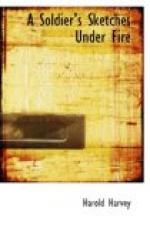Three rifles are deposited on the steps of the fireplace—the usual position for rifles when not in hand, dropped inside canvas bags, bayonets protruding—kept well greased, to prevent them from getting rusty.
TRENCH PERISCOPE.
[Illustration: Trench periscope in use.]
The uses of a trench periscope are so well known that they need not be described. The feature of my last sketch of a trench from the inside is that it shows one in actual employment.
CHAPTER VII.
The ruse of A German sniper.
Snipers on both sides exhibited the most extraordinary artfulness, cunning and ingenuity in the discovery, adaptation and invention of “cover.” The great desideratum, of course, was to hide where we could see without being seen, to shoot from where there was least danger of being shot.
I helped to track and put an end at Houplines to one German sniper who had resorted to a ruse that I really think deserves the dignity of a short chapter all to itself. The story is tellable in a few words, and may be introduced by this drawing of “The White Farm,” so christened because of the whiteness of the walls of its house; although, as will be noticed, there was little of this or anything else left upstanding when I drew my sketch.
[Illustration: “The white farm.”]
The position shown is the entrance to the trench at this point, and the shovels, barrels, pails and water trough are all such implements as had been used in making and draining the cutting.
The cart shown is the “ration cart” used at night for bringing provisions from the Transport Corps wagon. It was usual for the ration parties (as elsewhere) to go out every night after dusk. These were even more than ordinarily dangerous excursions, as the enemy trenches commanded the road, we having captured the position from them shortly before. Hence sniping was continuous, and the cart was often hit and our men killed or wounded. We therefore took observations.
THE SNIPER WHO LIVED IN A TREE.
[Illustration: A German sniper’s nest]
In course of time we came to notice that the most dangerous part of the road lay between a willow tree-stump and the White Farm. Our men were shot here nightly in getting back to the trenches. A party was formed to make a tour of the field in which the tree-trunk stood. The first thing we noticed was that after we entered this enclosure the shots were less numerous. We split up in open order and approached the willow, taking care to drop to the ground on our hands and knees. As we neared the tree, lo and behold! a shot rang out from it and only just missed the corporal. He jumped up at once and we all followed suit.




